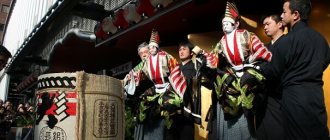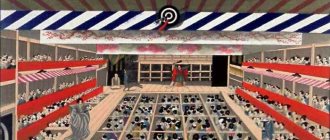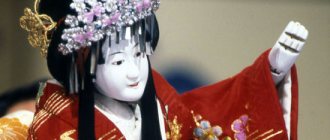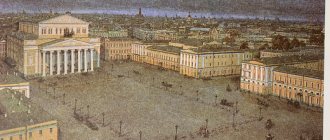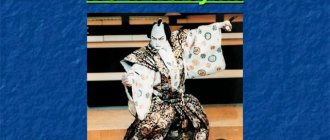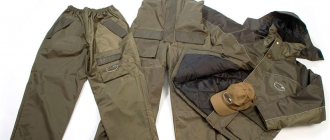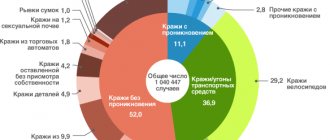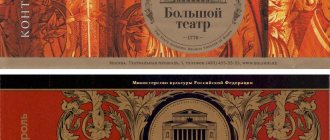Theater costumes. Wigs. Make-up (from the book “Japanese Kabuki Theater”)
Gunji M. It is clear that the theater uses costumes, wigs and makeup techniques that are not used in everyday life. Here I would like to draw attention only to some specific features of this area of theatrical art, in which the character of kabuki is especially clearly manifested. Theatrical costumes The theatrical costume of Agemaki, a courtesan of the highest rank, whose role is the most important for the onnagata actors in the play Sukeroku Yukari no Edozakura, is the height of splendor. On her upper cape (uchikake) made of black satin, pine branches, bamboo shoots and plum flowers are embroidered. From the shoulders to the sleeves there is a shime decoration woven from gold threads. On the back there is a pattern of tangerine fruits and yuzuri tree leaves, as well as a crab made of silk. On top of this are long gold and silver ribbons. On the lower cape, on a scarlet background with a monrinzu pattern, a bright tent for entertainment on the days of admiring cherry blossoms, drums engulfed in flames, and cherry blossoms scattered everywhere are woven. Long silver threads descend from the “manitaobi” [1] belt, reminiscent of the streams of a waterfall. There is also a carp embroidered with gold threads, rising against the current to the waterfall. The idea of this theatrical costume seems to personify the January, March and May holidays [2]. When Agemaki appears on stage for the second time, she is wearing a snow-white silk cape with an ink pattern, representing the harvest festival (August 1). She then appears wearing a kimono embroidered with chrysanthemums, signifying the autumnal September festivities. This common technique is used to depict the changing seasons and at the same time the five most important festivals in Japan. This reveals the author’s desire to emphasize the sophistication and significance of the theatrical costume itself. All this, one might say, has nothing to do with either the play itself or the portrayal of Agemaki’s character as a character. This costume recalls the origins of kabuki from the once existing furyu style. At first, the furyu style was associated with the unique design and decoration of festive chariots and clothes. It then spread to the performing arts when dancers began dressing up in furyu style costumes. Agemaki's theatrical costume indicated that these traditions were preserved in the clothing itself. When servants from the “fun quarters” or four brave samurai strongmen, spreading their knees, show decorations hanging from their belts, or before lowering the curtain, the Kurogo specially straightens the actor’s sleeves to create the impression of a blossoming peacock’s tail, performing art is manifested in this concept and movements. Furyu style. If Agemaki appeared on stage three times, each time changing her theatrical costume, then later techniques began to be used that made it possible to change the costume right on stage. They were called "hikinuki" and "buccaeri". The hikinuki technique consisted in the fact that it was enough to pull the corresponding strings, and the outer suit would fall, and another would be underneath it. In bukkaeri, the costume was turned from the shoulders to the other side directly on the actor. The hikinuki method was used in most cases to create an immediate and immediate feeling of change in the audience. For example, it is used in various dojo-type dance pieces. Simultaneously with the change of theatrical costume, the atmosphere of the stage also changes. Quite often the music and its rhythm change. When the bright red outerwear instantly falls off, underneath it reveals a suit of a delightfully beautiful blue color, on which the pattern that was on the red suit is repeated, depicting the branches of a cherry tree drooping downwards. This repetition of the pattern seems to warn that the previous musical theme will be continued after some time in this scene. Thus, an amazing combination and interaction of visual, auditory and musical perception occurs here. The bukkaeri technique is used in cases where it is necessary to show the transformation of ghosts or werewolves, or when the true character of the hero hidden under a different guise is revealed. Unlike the hikinuki technique, bukkaeri is used to show a transformation that has a semantic purpose. In order to show that the courtesan from the play “Seki no to” is the spirit of the beautiful cherry tree, that the guard at the Kambei outpost is in fact none other than the rebel Otomo no Kuronushi, they resort to changing the theatrical costume in the bukkaeri way. The same technique is used to show the true character of Ichijo Daizokyo, hiding under the guise of a fool. So, in order to reflect the change in the character of the actor, in this case the costume is discarded or the actor is directly wearing it, whereas in the noo theater, etc., for the same purposes, on the contrary, they specially put on a different costume (“monogi-se”) [3 ]. But although these techniques are opposite in form, they are the same in spirit and traditions. When a theatrical costume is removed on stage or a new one is put on, this indicates a change in the character of the character or the appearance of new, hitherto unknown features in his character. “Hadanugi” also pursues the same goal [4]. In one of the wonderful ancient dances in the furyu style, girls dance with their right shoulder freed from their outer clothing and tied with only one “tasuki” [5]. This technique of hadanuga comes to mind when watching the play “Imoseyama Onnateikin”, namely, when in the scene in the palace the heroine of the play Omiwa, bursting into tears, dances “Take-su”. With the advent of noo plays, keran dance performers also freed the right shoulder from clothing. Obviously, here too the tradition of ancient dances continued, when it was believed that a kind of divine inspiration descended on the performers of the Köran dances. The technique of hadanuga in keran dances is designed not only to evoke aesthetic pleasure in the audience. It is not a product of a play, but is a form of expression of feelings born in ancient times among the people. The same, obviously, can be said regarding the use of the tasuki cord in the theater. They tied him up not only to make it more convenient to work. The thick cord of nyodasuki in the play “Shibaraku” seems to symbolize the supernatural strength of the hero. The use of such a cord dates back to the ancient festivals of “Mikawa no Hanamatsuri” and “Niinu no Yukimatsuri”, during which a devil appears, belted with a thick tasuki. All this indicates that such techniques arose long before kabuki. The same can be said about the use of hard paper “chikaragami” [6] and high geta [7] by actors in fight plays (aragoto). It should be noted that the brilliant nature of kabuki plays lies in the revival of these old traditions in a new way. When the late Ichikawa Sadan-ji came to Russia with the play Narukami, the Soviet audience was apparently very impressed by the scene during which the temple abbot, unable to resist the charms of Kumo no Taemahime, is replaced by a snow-white robe using the bukkaeri method on a dress decorated with flames, as if symbolizing the changes that had taken place in his character. At that time in Russia they said that in the Kabuki theater even the theatrical costume is used to express the change that has occurred in the character of the hero. It is believed that this technique was soon used in Russia during the production of Salome. I think that the influence of kabuki should also be seen in the technique that was used in the Soviet film “The Stone Flower” (this film was shown in Japan after the war), when the heroine of the film, walking through a cave, changes her dress as she passes past different gems. There is another very important feature in the kabuki theatrical costume. It lies in the so-called temporary dissonance. For example, Ono no Komachi in the play "Rock Kasen", being a character from the Heian era, appears on stage wearing a fukiwa wig, which, according to Kabuki canons, can only be worn by princesses (although in the play Ono no Komachi is not a princess), and to Moreover, such a wig began to be worn only during the Edo period. The hifu cape she wears only appeared during the Tokugawa period. It also implies that Ono no Komachi is the favorite concubine of a high-ranking official, which is not the case. In the next scene, when Ono no Komachi confronts Kuronushi, so to speak, her costume looks comical, since she is wearing twelve kimonos, over which a tasuki cord is tied [8]. However, anyone who would say that such a technique is primitive would simply be ridiculed by Edo period audiences. Kabuki audiences in past eras liked it when ancient heroes were somewhat altered in a modern way, and they enjoyed the attractiveness of fiction, in which the beauty of the plays of this theater school was manifested. They enjoy the play, aware of the presence of temporary dissonance. It is difficult to even imagine how much the Meiji “living history” plays, in which the creation of theatrical costumes strictly followed historical accuracy, lost their dramatic appeal. Since the Kabuki theater is of the opinion that the theatrical costume should correspond not to the characters, but to the actors performing their roles, the costume design necessarily contains an image of the coat of arms of the acting dynasty and the colors adopted in this dynasty. I must say that the audience themselves like it. They are delighted when they see Danjuro's coat of arms (mimasu - three squares one in the other) on his dress in the play "Gosho no Gorozo" or on his belt in the play "Sukeroku", when they see the image of "yokikotokiku" [9] embroidered on Kikugoro's costume. Wigs (Katsura) Japanese hair does not have the variety of colors and textures inherent in the hair of Europeans and Americans. But in the theater this is made up for by the variety of forms of mage - the upper part of the wig. The form of mage is different for people of different social status, gender and age. Kabuki theater is characterized by a huge variety of wigs. Onnagata actors alone use more than forty types of wigs. Actors performing in everyday plays wear wigs created in a more or less realistic manner. But plays about the past mostly use wigs, which have a somewhat symbolic meaning. The extraordinary, unique nature of the beauty of kabuki is to a large extent the result of a complex organization that has developed over many years, a consequence of the sometimes minute, but strictly defined division of labor. And in the field of wig making, the complexity of the division of labor is simply astonishing. Thus, the katsuraya is in charge of making wigs, the styling of the upper part of the wig (mage), as well as decorations (combs, hairpins) is in charge of the tokoyama. In addition, Tokoyama is divided into Sankai and Chunikai. Sankai is a hairdresser who services actors for the main male roles. Chunikai specializes in onnagata women's wigs. Moreover, neither of them in any way interferes with the sphere of activity of the other. An interesting example can be given with Kesataro's wig from the mime scene of Miyajima no Dammari. Since Kesataro dresses up as a prostitute during the action, his wig is a complex structure that must include elements of both male and female hairstyles. In this case, the front part of the wig and the part adjacent to the back of the head, which are elements of a man's hairstyle, are styled by a sankai hairdresser, and the sagegami element (something like a braid), characteristic of a woman's hairstyle, is adapted to the wig by a tyunikai hairdresser. The Omiyo wig from the play “Chideimiya Shinsuke” is made in the same way, which is worn when performing tekomai dances [10]. It should also be noted that in the Kabuki theater, when the theatrical costume is changed, the character of the wig often changes. When Tamate in the play "Gappo" or Kampei in the play "Chushingura" die on stage during the action, then in mortal agony they pull out the fastening pin from the wig and the hairstyle randomly falls apart, covering the face with hair, or its upper part slides to the side. Quite often the actors free their shoulders from the upper part of the costume and their performance takes on an unusually “sharp” character. In order to change the hairstyle during the play, a wide variety of means are used. So, for example, when the late Nakamura Utaemon played the role of Omiwa, the court maid of honor, who mocked Omiwa, would secretly tie a long ribbon to the hair clip holding her hair together and at the appropriate moment would pull it. The hairpin fell out, the hairstyle fell apart, and the hair fell randomly on the heroine’s face. The wigs of the Kabuki theater also had subtle features that very few spectators could recognize. And this was also one of the elements of the attractiveness of his plays. For example, Musiri wigs differed in the absence or presence of a crown, which should have indicated some differences in the nature of the role. This expressed the conventional nature of kabuki plays. Additional wig details such as omatsuri, tosaka and shike cannot be ignored, as they convey some of the nuances and subtleties characteristic of a given theater. Omatsuri consists of strands of hair protruding to the right and left above the back of the wig. They give the character of the character an erotic shade. Omatsuri is also used in the wig of a dashing, cheeky bearer, etc. Tohsaka is usually added to the wig in order to enhance the meaning of the top part of the hairstyle. This detail is often used by performers of ancient tekomai dances. Even or uneven cutting of the edge of the tosak also indicates differences in the character of the characters. Among the above-mentioned additional details of the wig, a special variety is inherent in sike. Sike - strands of hair hanging from the side of a bin wig. They differ both depending on the nature of the characters and on whether the play is everyday or historical. Thus, Masaoka from the play "Sendai-hagi" is characterized by strands called "onid-zike", and for the wayward prostitute - "itozike". In addition, the shike strands on the left and right are connected to each other, and if you pull one of them, the second disappears, and the first becomes excessively thick and long. This technique is also used to show a change in the character of the character. We must also not forget that additional nuances and shades in the character of the characters in plays are conveyed with the help of various combs, hairpins, overlays made of thick paper and fabric, etc. Make-up (Kumadori) Kumadori is a well-known method of make-up in the Kabuki theater. It certainly resembles a mask in some way. All genres of performing arts that preceded kabuki were, one might say, mask performances. In gigaku, bugaku and nogaku, masks were always used. One of the revolutionary changes carried out by the kabuki theater was the abandonment of traditional masks. But in the Kumadori makeup method there remains, as it were, a memory of these masks. Kumadori is a method of makeup specific to the Kabuki theater, characterized by its unique beauty. In general, the red color in makeup symbolizes justice, passion, courage, blue - composure, anger, immorality, black and brown - divinity, otherworldliness. Here are the different types of kumadori. From top to bottom and left to right: a) Hankuma, Nihonkuma, Mukimicuma. b) Dzarekuma, Waraikuma, Sarukuma. c) Tsuchigumokuma, Kugeare, Hannyakuma. d) Tanzenkuma. Kaenkuma, Sujikuma. Kabuki theater has achieved great success in the field of theatrical makeup. It should be noted that Japan once had its own unique views on makeup. So, for example, whitewash was applied to the face not only for the sake of beauty, but also in order to acquire the same supernatural powers that a person acquired by wearing a mask. In ancient times, young novices of temples put on makeup during festivities in order to incarnate themselves as gods, to become heralds of their will. In the song from the play “Mu-sume dojoji” there are these words: “Why did you put rouge on your cheeks and paint your teeth black? To show your devotion to your loved one.” This passage emphasizes the desire to demonstrate one's devotion by applying makeup to one's face. It is interesting that in the feudal era, for example, applying makeup to the face showed respect for elders and people of high rank. Samurai, dai-myo and the emperor's courtiers gave particular preference to rough makeup, when cosmetics were applied to the face in a thick layer. In this case, it was assumed that appearing in front of your husband or master with an unmade up face was considered indecent. At the same time, prostitutes, contrary to the generally accepted opinion that they abused cosmetics, did not use rouge or whitewash, and geisha used them only to a minimal extent. These general views on makeup were not, of course, necessarily transferred to the stage, but society’s perception of it had to be reflected in the theater. Particular attention is paid to the makeup actors-ongates, spending a lot of effort on it. One of the techniques giving specific attractiveness to the actor’s face is Metsuri - pulling up the outer edge of the eyelids. Usually, before the wig is put on, wrinkles are smoothed on the forehead and pull the skin at the outer edge of the eyes to the side and upwards. When a hat is pulled over his head, on which the wig is then attached, the face acquires a very peculiar expression. There were times when the actors put makeup even on the eyes and tongue. So, for example, to show how in the play “Sambondzacu” in Tomomori, raising a heavy anchor, from tension, the actor launched blush in the eyes of blush. There are no such actors now, but in the old days they sacrificed their health to create a greater effect. A lot of actors died, poisoned by lead. They used exclusively poisonous lead white, since such whitewashes were well applied to the face. One of the last victims of these Belil appeared the late Nakamura Utaemon. In Kabuki plays there are such scenes when the actor must open his mouth wide and stick out his tongue. In these cases, the actors in the old days smeared their tongue with blush to emphasize its redness. This was used, for example, by the actors who played the role of Prince Tokyir in the Kurumabiki stage, Kuronusi in the play “Seki-Noto”, as well as the dance performers of Sitadasi Samban. All these specific techniques have recently begun to gradually disappear. But it should be noted that if we have groteseness from the original Kabuki, this will damage his essence. A characteristic feature of the role of make -up in the Kabuki Theater also lies in the fact that it changes right on the stage when the theater suit and a wig are changing in the course of action. In the play “Sharks” there is a scene when the abbot of the temple, who could not stand in front of the spell of Princess Taamakhime, gets drunk Sake and falls asleep. Taking advantage of this, the princess cuts the sacred ropes of Simenav, with the help of which the waterfall is stopped and the god of rain is locked. The rain God is freed, and rain spils on earth. The awakened abbot is convinced that he was deceived. He is anger. In accordance with his condition, clothes are changing on him, and he imperceptibly, right on the stage, applies the blue lines of the make -up of Kumadori on his face. Such a peculiar technique is an outstanding achievement of the Kabuki Theater. In the old stage texts of the play “Sugavaradendzu Tenaraikaga” it is said that when Sugavara appears on Mount Tampaidzan, his face immediately becomes red. Obviously, in this case, the technique of change of makeup was used directly on the stage. Disney films use the technique of psychological display using color (one of them shows how the dog’s face, which is sentenced to the death penalty, is shown right in front of the eyes; But this technique was used in the Kabuki Theater a few hundred years before the appearance of Disney films. I must say that here is the fact that Kabuki plays do not belong to the genre of plays based on realism.
Stages of making up an actor for female roles - onnagata. Nakamura Jakuemon is a kabuki theater actor. Face without makeup. First of all, the actor's hair is tied with a special silk cloth, then white is applied to the neck. Using a special brush, a layer of thick white is applied to the face. Using a brush, paint is applied to the lips and eyebrows, and the eyes are tinted. A layer of white is applied to the hands and feet. The make-up artist applies whitewash to the back of the head. After the makeup is completely applied, a wig is put on the actor's head. The actor is then dressed in theatrical costume, starting with the lower kimono. The actor is put on an outer kimono and an obi belt is tied. The actor checks and touches up his makeup for the last time in front of the mirror. So, the kumadori makeup method is definitely not realistic. The word “kumadori” itself means “applying stripes to the face.” One theory about the origins of kumadori suggests that this makeup technique may have been influenced by Chinese theater, as it is similar to the makeup found in Lianpu makeup samples. The kumadori method developed along with the development of formalistic production of plays about the past. It became especially widespread in the Edo theater world, where romanticism and formalism were popular. Based on color, kumadori can be divided into three large groups. Kumadori in red shades symbolize justice and superhuman strength, while purple-blue shades symbolize fear and hidden anger. In addition, there are special colors of fudokuma and kumadori makeup used to display animals: shishiguchi, tsuchigumo, etc. From the point of view of the effect, kumadori are more formalistic in nature than the meaning of the symbol. This can be understood by comparing kumadori with the German Expressionist method of make-up and the method currently used in modernist ballet. They say that Danjuro the Ninth, in scenes where he had to depict anger on his face, strained the veins on his face and applied makeup directly to the swollen veins with wide strokes. Now that there is electric lighting on the stage, the makeup becomes finer and more and more takes on the character of a fine pattern. With the advent of electric light, the attractiveness of the old method of kumadori disappeared, and in the old days, in the dim light of a lantern brought to the actor’s face, these strips of makeup roughly applied to the swollen veins moved as if alive and made an indelible impression on the viewer. Modern kabuki theater has lost this effect. 1. "Manaitasbee". Typically, an obi is a wide belt with a bow on the back that is used to tie a kimono. Manaitaobi is a belt worn by courtesans. It is tied with a wide bow at the front and, thanks to the decorations on it, gives the courtesan’s clothing a special attractiveness. – Approx. 2. This refers to the New Year's holiday, the sakura cherry blossom holiday and the boys' holiday. – Approx. 3. In noo theater, this technique, called “monogise,” means changing clothes directly on stage. In Kabuki theater it is called "monogi". This dressing up on stage is accompanied by a special accompaniment - “dressing up music”. 4. Hadanugi means removing one or both shoulders from clothing. – Approx. translation 5. “Tasuki” is a special cord that goes around the shoulders. This cord is usually used to tie up the long sleeves of a kimono so that they do not interfere with work. – Approx. translation 6. "Chikaragami" - pieces of rigid paper tape that are attached behind the actor's shoulders at the base of the wig. They personify strength and masculinity. – Approx. translation 7. Geta - Japanese shoes on wooden stands. 8. This outfit gives the impression of being comical, because everyone understands the impossibility and pointlessness of using a tasuki to tie up sleeves (this is usually done so that long sleeves do not interfere with work) if a person is wearing Twelve Kimonos. – Approx. translation 9. “Yokikotokiku” - a pattern with an image of an ax, a musical instrument koto and a chrysanthemum, which is the coat of arms of the Kikugoro acting dynasty. – Approx. translation 10. “Tekomai” - ancient dances performed by women dressed in men's costumes. – Approx. translation
Gunji M. Japanese Kabuki Theater. M.: Progress, 1969, pp. 145-157.
- To section »
The meaning of the Samurai Mask tattoo
A samurai in a mask, or simply a samurai mask, or rather the so-called combat mask, is perhaps the most popular samurai-themed tattoo. Firstly, the creepy grin of a mangu, a battle mask, looks very interesting and exotic, and secondly, such a tattoo has an interesting semantic message.
Mengu is a part of samurai armor and such a mask was used only directly in combat. That is, a person who gets a tattoo with a Japanese battle mask declares that he is on the path of a warrior right now. He is ready for any difficulties and trials, he is, metaphorically speaking, always in full battle armor.
In general, we can say that a samurai tattoo is a very interesting choice of tattoo; such a design on the skin always looks impressive, but you need to familiarize yourself with the history and teachings of the samurai before making a choice. Even just as a tribute to the culture whose most interesting image you use.
First signs
A separate question concerns the appearance of the first signs of pathology. Since it is genetic, the problem can be recognized immediately after the baby is born. As a rule, experts talk about changes on the child’s face. At the same time, the signs may not be so bright at first, which, naturally, makes the diagnosis somewhat delayed. Among the main symptoms are:
- A special shape of the eyes, when the corners are slightly lengthened, in this case the eyes will be slightly larger in size than usual.
- Strabismus also happens, and it can be one-sided or in both eyes at once.
- The eyelashes of such children are very fluffy, they are compared to those of a doll.
- It happens that an inversion of the lower eyelid is formed - ectropion.
- Flattened nose with a wide bridge.
- The eyebrows are arched, strongly curved, sparser at the edges than in the middle.
- The ears are low set, large in size and protruding. In situations where there is deformation of the auricle, the child has hearing problems.
In addition, children with Kabuki syndrome are characterized by short stature, developmental delays (both physical and mental), and intellectual problems are common. As a complementary picture, there are also symptoms such as abnormalities in the area of the skull bones, problems with the teeth and hard palate, damage to the joints and their hyperextension, and curvature of the spine.
The look of a mutant. The most unusual and rare eye diseases Read more
